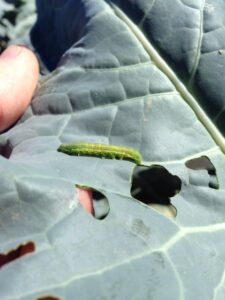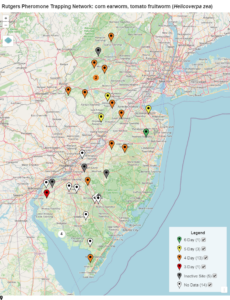Sweet Corn
Corn earworm (CEW) moth captures from northern and central blacklight and pheromone traps continued to decrease with an extended period of cooler night temperatures. Pheromone trap information is available from all northern and central sites, but is limited from southern New Jersey. With little information from South Jersey, growers there would be wise to assume numbers at least as high as those represented in the central and northern traps. Should night time temperatures rebound, we should expect increases in CEW catch from both trap types. We will use a combination of pheromone and blacklight trap types to derive silk spray schedules by region. Silking corn is at risk of CEW infestation at this time. Be sure to access information from this publication in the upcoming weeks to determine how frequently you should treat silking sweet corn to protect it from CEW infestation.
The highest nightly blacklight trap catches of CEW for the week ending 9/18/24 are as follows:
| Denville 3 | Flanders 2 | Califon 1 | Lawrenceville 1 |
| Blairstown 2 | Hackettstown 2 | Farmingdale 1 | Long Valley 1 |
| Chester 2 | Sergeantsville 2 | Georgetown 1 | Pennington 1 |
The highest nightly pheromone trap catches of CEW for the week ending 9/18/24 are as follows:
| Woodstown 68 | Berlin 16 | New Egypt 7 |
| Georgetown 20 | Bellemeade 10 | Chester 6 |
| Snyder Farm (Hunterdon) 19 | Green Creek 10 | Hackettstown 6 |
| Califon 18 | Middle Valley 10 | Dayton 5 |
Thanks to Joe LaForest of Univ. of GA, and the Southern IPM Center for producing maps from our NJ CEW data!
Using our current pheromone- based thresholds (30″ Hartstack trap) developed by the Univ. of Delaware, nightly corn earworm moth catches translate to:
0 moths – 6-7 day spray schedule
1 moth – 5 day spray schedule
2-20 moths – 4 day spray schedule
>20 moths – 3 day spray schedule
Silking Spray Schedules*:
South – 3 days
Central – 3-4 days
North – 3-4 days
*These recommendations are based on regional catches. Adhere to tighter spray schedules if indicated by local trap catches. Synthetic pyrethroids alone should NOT be used for corn earworm (CEW) protection on silking corn, or for fall armyworm (FAW) management at any stage. Control with these materials is very inconsistent.
Beet Armyworm
Beet armyworm (BAW) numbers in pheromone traps in the Woodstown area of Salem County have dropped over the past week, but remain relatively high. Thanks to a grower cooperator in that area, we know that catches range from 31 – 67/night over the past week in local traps. This pest can cause significant injury on peppers as well as leafy greens like swiss chard, and kale. Larvae are beginning to appear as far north as Hunterd on County, although it is likely that serious infestations are or will occur in southern NJ now. Monitor pepper fields weekly for signs of feeding. BAW larvae (photo at left) feed in the developing foliage in terminal growth of pepper plants. Initially, leaves are skeletonized, but as larvae grow, they will move onto fruit and damage these as well. In northern NJ, BAW is an occasional, and typically low level pest of cole crops. Infestations tend to be very local for unknown reasons. As with other armyworms, BAW is difficult to control with pyrethroid insecticides. Effective materials include spinosyns (IRAC 5) and diamides (IRAC 28).
on County, although it is likely that serious infestations are or will occur in southern NJ now. Monitor pepper fields weekly for signs of feeding. BAW larvae (photo at left) feed in the developing foliage in terminal growth of pepper plants. Initially, leaves are skeletonized, but as larvae grow, they will move onto fruit and damage these as well. In northern NJ, BAW is an occasional, and typically low level pest of cole crops. Infestations tend to be very local for unknown reasons. As with other armyworms, BAW is difficult to control with pyrethroid insecticides. Effective materials include spinosyns (IRAC 5) and diamides (IRAC 28).
Corn Earworm Traps – 30″ Hartstack type
Growers wishing to purchase corn earworm pheromone traps to conduct their own on-farm monitoring should contact:
Mike “O” Olsowski
3510 Sutton Rd.
Geneva, NY 14456
Phone: 315-651-5929
Mike O manufactures these 30″ Hartstack traps in his shop. These traps are the same as the ones we use currently in the IPM Program, and spray thresholds are based on this type.
Lures currently used in the Rutgers Vegetable IPM Program corn earworm pheromone traps are:
Hercon Luretape, available from Great Lakes IPM
Lures are placed in the clip at the base of the large cone, and a new one is added at two week intervals.
Welcome!
The Vegetable IPM Program welcomes Amanda Quadrel as the new Program Coordinator for southern New Jersey! Amanda received her MS. from our Rutgers Entomology Department, working with spotted wing drosophila. She has an excellent background in IPM tactics, and is currently meeting with growers and becoming familiar with some of our activities (though very late in the season) in the field. Welcome, Amanda and good luck!


